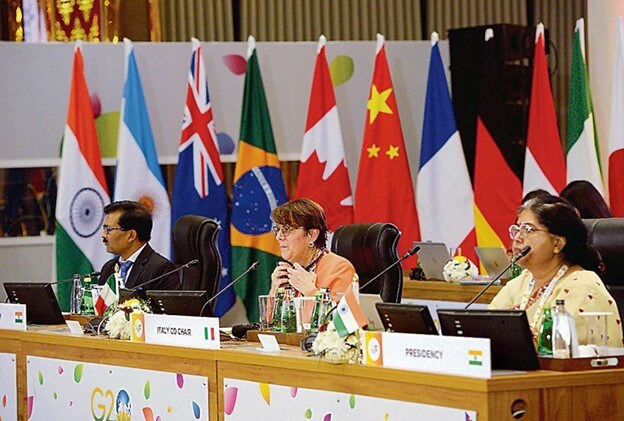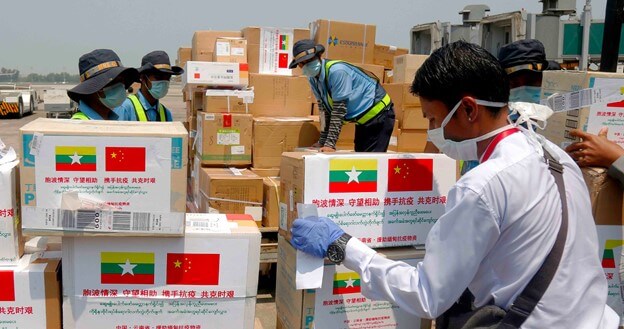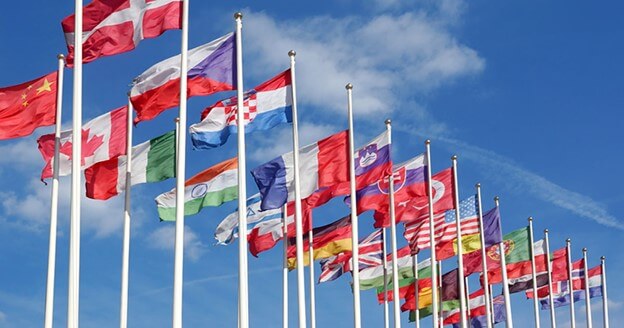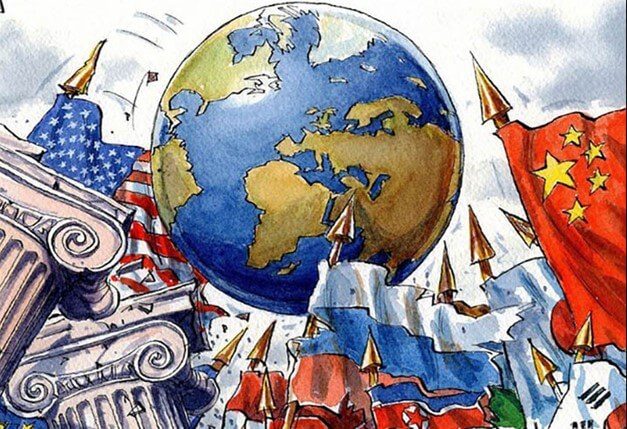Today’s insights are brought to you by our colleagues and global futurists, Graeme Codrington and Dean van Leeuwen.
The world is always changing, and geopolitics never stands still. But there are some moments in history that are more consequential than others, and we are living in one of those right now. As part of our “Grey Elephants” series, we present the sixth megatrend shaping the world: multipolarity. (If you’ve missed the previous five trends, see the links at the bottom of this article.)
The term “multipolarity” refers to a geopolitical landscape where multiple centres of power exist, often in contrast to a unipolar or bipolar world order. In a multipolar system, power is dispersed among various players — countries, organisations, even non-state actors — each with its own set of interests and capabilities. For most of the 20th century, Russia and America were locked in a “cold war” creating a bipolar world (with many “non aligned countries” trying to remain neutral). With the collapse of the USSR, America had a period of unipolar dominance, aided of course by the near universal use of the dollar as the accepted reserve currency.
Not willing to accept Russia’s reduced role on the world stage, Vladimir Putin has long been talking of a new multipolar alignment, trying to get India and China specifically to partner with him. This has not worked out as he planned. However, it is becoming clear that the majority of nations and the global population do not want a unipolar or bipolar system – they want some form of multipolarity. Old alliances are breaking (think of Brexit), historical relationships straining (think NAFTA or Taiwan), existing alliances shifting (think NATO, the EU and the Middle East) and new structures emerging (think of the recent addition of six nations to the BRICS+, or the Africa Union being added to the G20).
Some formulations of multipolarity come with immense ideological baggage, but whatever is driving them the trajectory is clear: centres of power, global alliances and geopolitical relationships are being tested and rewritten. This will change everything.
In addition to the political drivers of multipolarity, many other forces are combining to accelerate and exacerbate this change. As mentioned in an article by McKinsey, “disruptions to supply chains driven by geopolitical and trade issues as well as the COVID-19 pandemic, and marked regional differences in customer behaviours” are changing the existing global systems. Some of these shifts, within global economic systems and tech infrastructure, were already becoming fragmented before 2020, but the pandemic drastically sped up this process, politicising travel, immigration and entrenching a bias towards nationalism and self-reliance.
One of the main results of the past few years has been an accelerated shift from ever expanding globalisation toward rising regionalisation of the global economic and political systems. In addition, the climate crisis and disruptive environmental factors have triggered and aggravated “multiple economic, social and existential emergencies to which insufficient responses [were] given.” This has led to questions about global chaos and change… and what the implications are in terms of power.

China after the pandemic
We are discovering just how dramatically the pandemic has reshaped world power. There has been concern, especially from the West, that the virus was a tipping point for China to overtake its superpower rival, the US.
China worked hard to turn COVID-19 into a success story. In essence, the pandemic became a battleground for a face-off between the ideologies of authoritarianism and democracy. By offering assistance to badly affected countries, China used the crisis to further reinforce its credentials as the go-to global leader, especially in countries who view the West as having abandoned them. Who would have imagined, pre-pandemic, pictures of Chinese doctors and nurses being sent to Italy on humanitarian missions?

Global Rebalancing
The rise of countries like China, India, and Brazil has led to a shift in global power, challenging existing hegemonies.
More than the pandemic, China has also gained dominance in strategic industries from 5G telecoms to battery technology. According to the Benchmark, a London-based agency, in 2019, “China accounts for 23 per cent of the global mine-output of battery minerals. Yet its chemical companies churn out 80 percent of the world’s processed battery grade raw materials and 66 per cent of the global production of cathodes and anodes for Li-ion batteries.” In terms of battery factories, China now dominates. In 2020 China led the world’s battery cell production with a 63.2 percent share, while the US was in second place with 14.2 per cent.
None of the Western powers want to live in a world where China controls 90 per cent of the active ingredients for antibiotics and dominates battery and other strategic technology. But as foreign policy and diplomacy have become multipolar, rather than unipolar, nations are pursuing strategic autonomy rather than alignment. As a result of fragmented geopolitics, there has been a shift to more regional, local norms and governance models. Western countries have had to adopt nuanced diplomatic strategies, cooperating with China in some areas while competing in others.
America, whether under Republican or Democrat leadership, appears to now see China as a major competitor, and both countries are looking to place restrictions on each other.
BRICS+
At a conference of the BRICS (Brazil, Russia, India, China and South Africa) nations held in South Africa in September 2023, a total of 77 nations sent high level delegations, each one trying to find a way to be included in this club. Six nations were formally added: Argentina, Egypt, Ethiopia, Iran, Saudi Arabia and the United Arab Emirates. The BRICS 11 account for just short of half the world population, and around 36 per cent of global GDP.
It is probably sometime away, but the very talk of a BRICS currency to rival the dollar, and BRICS banks to ease cross border trade indicate serious ambitions for these “Global South” nations.
Implications for businesses
Given the complexities of a multipolar world, it’s crucial for businesses to adopt a multi-faceted strategy that accounts for various geopolitical and socio-economic variables. Here are some practical ways businesses can navigate this landscape while keeping a global perspective:
- Strategic Autonomy: Companies should strive for independence from a single supplier for critical components.
- Global Partnerships: Businesses can look to form alliances that align with shifting diplomatic relations.
- Policy Adaptability: Be prepared for a changing regulatory landscape as different powers push their own standards.
- Diversify Suppliers: Avoid dependency on a single region or country for crucial materials or services.
- Data Localization: Invest in technology that can easily adapt to local data storage and processing requirements.
- Localized Marketing Strategies: Tailor products, services, and communications to suit local customs and tastes.
- Form Strategic Alliances: Partner with local companies or organisations to tap into established networks and gain local expertise.
- Global Sustainability Framework: Adopting a global sustainability agenda can serve as a unifying theme across markets and reduce friction.
Neutrality / Lines you won’t cross: Where possible, businesses would do well to remain neutral in global conflicts, culture war issues and diverse worldview clashes. But there will come a time when neutrality is no longer an option – you need to know how you will navigate these issues as they arise.
In summary, success in a multipolar world requires a balanced, nimble, and globally-minded strategy. The ability to navigate this complex web of international relations, norms, and dependencies is vital for any business or organisation. It’s about foreseeing challenges, grasping opportunities, and making data-driven decisions that take into account a myriad of international factors. In a multipolar world, no country or company exists in isolation; strategies must be developed with a global perspective in mind.
By acting responsibly and creatively, business leaders have the opportunity to turn the tide against this disruptive Grey Elephant. It requires a commitment to ethical leadership, community engagement, local networking and innovative thinking, positioning businesses not just as profit-driven entities but as integral parts of our society. This could also propel the kind of new thinking required for a radical redesign of the global economic system to something fairer and more inclusive.

The Grey Elephant Framework:
Change, by its very nature, can be intimidating and unsettling. It’s tempting to put the blinkers on, cling to familiar terrain, and hope that life carries on as usual. But for business leaders, entrepreneurs, and visionaries, change doesn’t merely signal a time of adaptation or upheaval; it represents opportunity. It’s a thrilling prospect, especially when we realise that our research reveals we’re living in a kairos moment – a unique time of potential, ripe for the taking. Those leaders who are attuned to change, who possess the foresight and agility to understand its nuances, can seize opportunities not just to adapt but to shape the future. The question is no longer about whether deep structural change is happening, but how we position ourselves within its dynamic flow.
At TomorrowToday Consulting, we believe that the best way to predict the future is to create it. The Grey Elephant framework is a tool designed specifically to assist in this regard. Acting as a radar, this framework empowers leaders to think like futurists, discerning opportunities, preparing for, and harnessing the forces of change.
What exactly are Grey Elephants? They can be succinctly defined as “a highly probable, high impact but ignored force of change.” The contemporary challenge lies not just in identifying a singular Grey Elephant but in recognising that there is a whole herd of them, poised and ready to stampede.
The seven Great Grey Elephants defining this new age of discovery encompass diverse and potent forces:
- Ageing – The demographic shifts and implications of an ageing global population
- Angry Planet – The urgent realities of climate change and environmental disruption
- Inequality – Persistent disparities in wealth, access, and opportunity
- Big Squeezes – Economic pressures and constraints
- Angry People – Social unrest and dissatisfaction
- Multipolarity – Emerging global power dynamics and geopolitical shifts
- Intelligent Assistance – The rise of AI, robotics, and smart technology
Read more about all 7 Grey Elephants here.
Sources:
- “Business and Dynamic Change: The Arrival of Business Architecture” by Fred A. Cummins
- “World Out of Balance: Navigating Global Risks to Seize Competitive Advantage” by Paul A. Laudicina
- “The China Strategy: Harnessing the Power of the World’s Fastest-Growing Economy” by Edward Tse
- “The Future of Power” by Joseph S. Nye Jr.
- “The New Silk Roads” by Peter Frankopan
- “The Post-American World” by Fareed Zakaria
- “Global Trends 2040” by National Intelligence Council
- “The Future is Asian” by Parag Khanna
About the author of today’s Tuesday Tip – Graeme Codrington and Dean van Leeuwan
Graeme Codrington, is an internationally recognized futurist, specializing in the future of work. He helps organizations understand the forces that will shape our lives in the next ten years, and how we can respond in order to confidently stay ahead of change.
For the past two decades, Graeme has worked with some of the world’s most recognized brands, travelling to over 80 countries in total, and speaking to around 100,000 people every year. He is the author of 5 best-selling books, and on faculty at 5 top global business schools.
Dean van Leeuwen is the co-founder of TomorrowToday Consulting – a futurist consultancy working with leading organisations around the world. He is an expert on global trends, innovation, and strategic business transformation.
You can access Dean’s latest research on ‘Closing the Innovation Gap – The 7 strategic and cultural essentials that separate successful large-company innovator’s here or chat with us about our ‘Full blown innovation’ keynote presentation.


